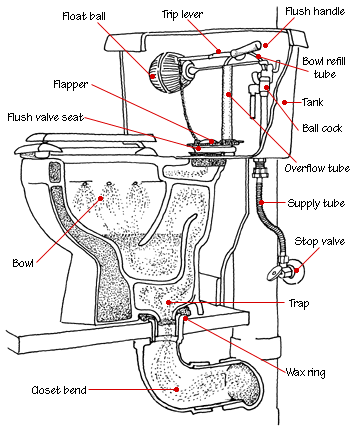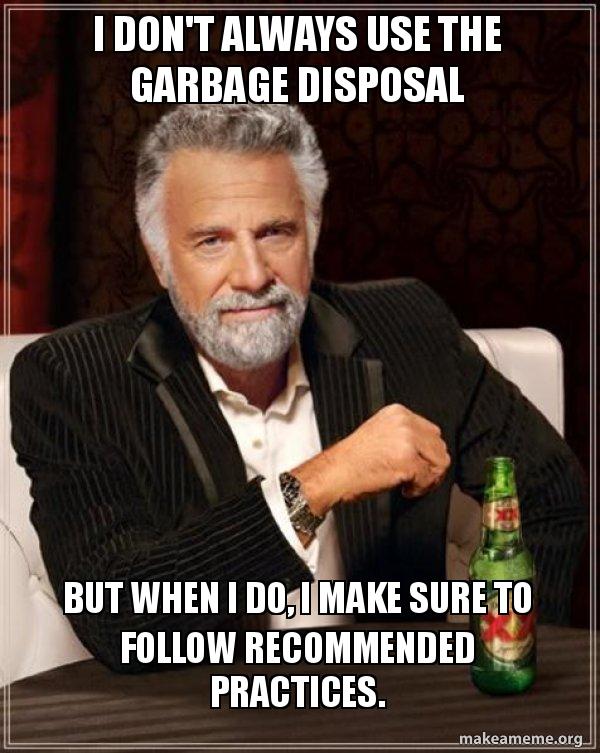|
So you pushed the lever, the toilet has filled and now all you've got is a bowl full of troubles.
What do you do? This article will go over how toilets work, fixes you can try for clogs and when to call a professional. How a toilet works: A toilet has two main parts: the tank and the bowl. The tank houses the flush/refill mechanism and water for flushing (1.28 gallons for high efficiency toilets, all the way up to 7(!!!!) gallons for older toilets). The hole at the bottom of the bowl connects to a siphon tube and eventually to a 4" drain that goes out to the sewer line. The siphon tube curves up and then down again (it's that intestine-y looking thing on the side of the toilet base). In order to flush the toilet, enough water must be added to the bowl to flow over the upward curve of the siphon tube. This action sucks everything from the bowl into the sewer pipe. Want more detail on how flushing works? Here's a quote from writer Philip Schmidt, from his article about troubleshooting your toilet's flushing mechanism: "A toilet's flush action is powered by three things: water pressure, gravity and you (the Flush Master). The big tank at the back of the bowl is full of water, and it's elevated above the bowl. When the Flush Master activates the handle, it pulls on a chain inside the tank, which in turn lifts a little rubber trap door (called a flapper). This lets the water in the tank rush down through a big hole and into the bowl, creating the familiar swirling action and, ultimately, the flush that empties the bowl. When the tank is empty, the flapper drops back down over the hole. Meanwhile, a float that's attached to the flush-and-fill valve (also called a "ballcock") has dropped with the exiting water, triggering the valve to open and refill the tank. The float rides atop the rising water and shuts off the valve at the preset level." Ok, this is great and all but...my floor is still in danger of being wet. In general, if you're toilet isn't flushing, it is likely one of two issues. Either there's a problem with the flush mechanism itself, or there is a problem with the drainage system (aka: a clog). If the toilet flushes (ie: the bowl fills with water but it's not going anywhere), then you've got a drainage issue. Since the bowl is full, you've probably come to this conclusion yourself. So what now? First, if the toilet is in danger of overflowing, remove the lid of the tank and seal the hole at the bottom of the tank with the flapper. This will stop more water from entering the bowl. You may need to get your hand wet to do this. Don't worry. This water is straight from the line and has not cycled into your toilet yet (only the tank). If this doesn't work for whatever reason, locate the supply line behind the toilet and turn the stop valve to "off." This will prevent water from coming from the line into the tank. (If you have to take this step, give us a call right away.) Next: get a plunger and go to work. Make sure the flange on the plunger completely covers the hole at the bottom of the bowl. Make a good seal and push down as much as you can, then pull up. Try this a few times, then flush the toilet. If it doesn't work, try once more. If this still doesn't work, you have a choice to make. Option 1: if you own a toilet auger, it's time to break it out. These dudes are the little brothers of drain snakes used by professional plumbers. They are about 6' long and cost around $50. To use it, insert the auger head into the drain and feed the cable further into the drain by cranking the handle and pushing down on it. Keep cranking the handle after you've broken through the clog to make sure you completely clear the blockage. This can be easy to do, or it can take a lot of pressure if you have a major blockage. If you've broken through the blockage, you should be able to flush the toilet successfully. If not, then there's always Option 2. Option 2: If you don't have a toilet auger or if the idea of using one does not appeal to you, give us a call. We are happy to help. Check out the construction of this wall. Lath and plaster were commonly used in construction in the United States up until the late 1950's. After that time, drywall began to replace lath and plaster construction.
If your house has lath and plaster walls that means that your pipes (unless they have been updated or replaced) are probably 60 years old or more. Working with these old pipes takes practice and skill. Luckily, Anthony has been working in South Park and the surrounding areas for over 20 years and has a TON of experience with these older systems. If you have an old house, give us a call, we are happy to help. As we all know, California has been experiencing serious drought for many years now. Although last season's rains were plentiful, scientists tell us that we would need several more years of record rainfall in order for our underground aquifers to return to previous levels.
At Community Plumbing, we want to find ways to help our customers prevent water waste and conserve as much as possible. Some common plumbing issues that contribute to water waste are: leaky pipes, running toilets, outdated plumbing systems and faucets that don't quite shut off. Even a slow drip can make a HUGE difference in your water bill and in the amount of water wasted. A recent customer called us because she saw a huge spray coming from under her house. What she didn't know was that she had had a slow leak for many months before the break occurred that caused the spray. The whole underside of her home and the entire front slope of her property were soaked with water and very close to sliding away. Tiny leaks can add up quickly. A slow drip can add up, one tiny drop at a time, to nearly a gallon a day or 350 gallons per year. Multiply that times the number of leaks city wide and we're talking some serious numbers. The best way to prevent leaks like this is to hire a professional plumber to come to your home and inspect the plumbing system once per year. We can detect tiny flaws and bring them to your attention before they become major problems. Regular maintenance of your plumbing can prevent emergencies and save you money (and water) in the long run. In addition to regular inspections, there are additional steps you can take. Switching to low flow shower heads and a low flow toilet can save about 250 gallons of water per week. Only running the dishwasher when it is full can save 1-3 gallons per load. Turning off the water when you are brushing your teeth or shaving can save 3-5 gallons per day. In addition to these suggestions, the city of San Diego has a great website with more tips: https://www.sandiego.gov/water/conservation/kids/tips. Whether you need a plumbing inspection, would like help changing fixtures over to low flow or have a plumbing emergency, give us a call, we are happy to help. Keeping our trucks clean (inside and out) makes for happy plumbers.
Using tons of sudsy pink bubbles makes it extra fun. They say that fire and water don't mix but this looks incredibly relaxing to us. There's even room around the tub to set up a book stand and have a snack.
Yep, this looks like heaven. eIt's fall and that means the holidays are coming up fast. Dining rooms will soon be filled with family and friends and our kitchens will be getting a workout.
One of the reasons that fall is such a busy time for plumbers is that folks end up putting all kinds of things down garbage disposals that are better used for compost. Here's a short list of foods that should not be sent down the disposal:
If you're disposal clogs up or stops working, give us a call, we're happy to come out and help. All dad jokes aside, how neat is this thing? Cold water goes in, magic happens, and hot water comes out in an unending flow.
There's a lot to think about when considering if you want to convert your home to a tankless water heating system. It's a wonderful luxury to have an endless supply of hot water "on tap" but before you jump in and make the change, ask yourself these questions: Why do you want a tankless system?
What state is your electrical system in?
|
AuthorCommunity Plumbing is a local San Diego plumber serving residential and commercial properties. Archives
January 2018
Categories |









 RSS Feed
RSS Feed